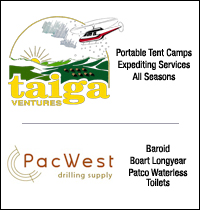Agnico-Eagle Mines Ltd., a gold exploration and development company with six operating mines in Canada, Finland and Mexico, has signed a letter of intent with Miranda Gold Corp. to earn a joint-venture interest in the junior’s Ester Dome project, located in the Fairbanks Mining District of Alaska.
Under terms of the agreement reported by Miranda Oct. 14, Agnico-Eagle can earn a 51 percent interest in Ester Dome by spending US$4 million on the project over a five-year period. The Toronto-based miner may then elect to earn an additional 19 percent stake by completing a feasibility study or by spending another US$10 million at a rate of no less than US$1 million per year.
The Ester Dome project consists of 181 Alaska state mining claims covering around 13.8 square miles, or 35.7 square kilometers, and is located 5 miles, or 8 kilometers, west-northwest or Fairbanks. The Fairbanks district has produced over 9.5 million ounces of placer gold, more than 3 million ounces of it mined on the flanks of Ester Dome. The property covers the majority of the upland source area for this historical production.
Ester Dome’s geology comprises a suite of metamorphic rocks, primarily schist separated by thrust faults and cut by igneous sills and small stocks. The mineralization on the Ester Dome project is prospective for both high-grade vein and shear-hosted gold deposits and larger tonnage bulk minable gold deposits.
Fairbanks area gold deposits – such as Fort Knox, at around 6 million ounces hosted in an intrusive stock and characterized by sheeted quartz veins and shears, as well as True North, at 1.3 million ounces, hosted in complex imbricate shears with quartz veins in metasediments – provide target analogues for exploration at Ester Dome.
The most recent exploration on Ester Dome was conducted by Placer Dome Exploration in 1998. The best drill hole reported by Placer Dome intercepted 6 meters averaging 91.2 grams per metric ton gold starting at 110 meters.
Miranda’s work on Ester Dome in 2010 consisted primarily of limited reconnaissance prospecting that identified quartz veins in schist and intrusive rock, data compilation, and the completion of a soil grid consisting of 367 samples.
The purpose of the soil grid was to confirm, delineate and tighten the spacing of an irregularly sampled and undrilled soil anomaly previously identified by Placer Dome. Miranda said this 1,830-meter-by-366-meter soil anomaly is proximal to a cluster of small mapped and inferred intrusive bodies that occur in an area measuring around 1.5 square miles, or 4 square kilometers. Small gold placer workings occur immediately downstream from the area containing the intrusive bodies and soil anomaly.
Results from soil sampling are in the process of being compiled and evaluated. Miranda also submitted a permit application to build a road through the central part of the soil anomaly with the intent of providing outcrop exposure for mapping, sampling and access to drill targets.
Agnico-Eagle will continue to compile a large historic database for the project in anticipation of the 2011 exploration season.
Agnico-Eagle’s LaRonde Mine in Quebec is Canada’s largest operating gold mine in terms of reserves. In March, the 37-year-old company achieved commercial production at its new Meadowbank Gold Mine located in the Kivalliq region of Nunavut about 70 kilometers, or 43 miles, north of the community of Baker Lake.




